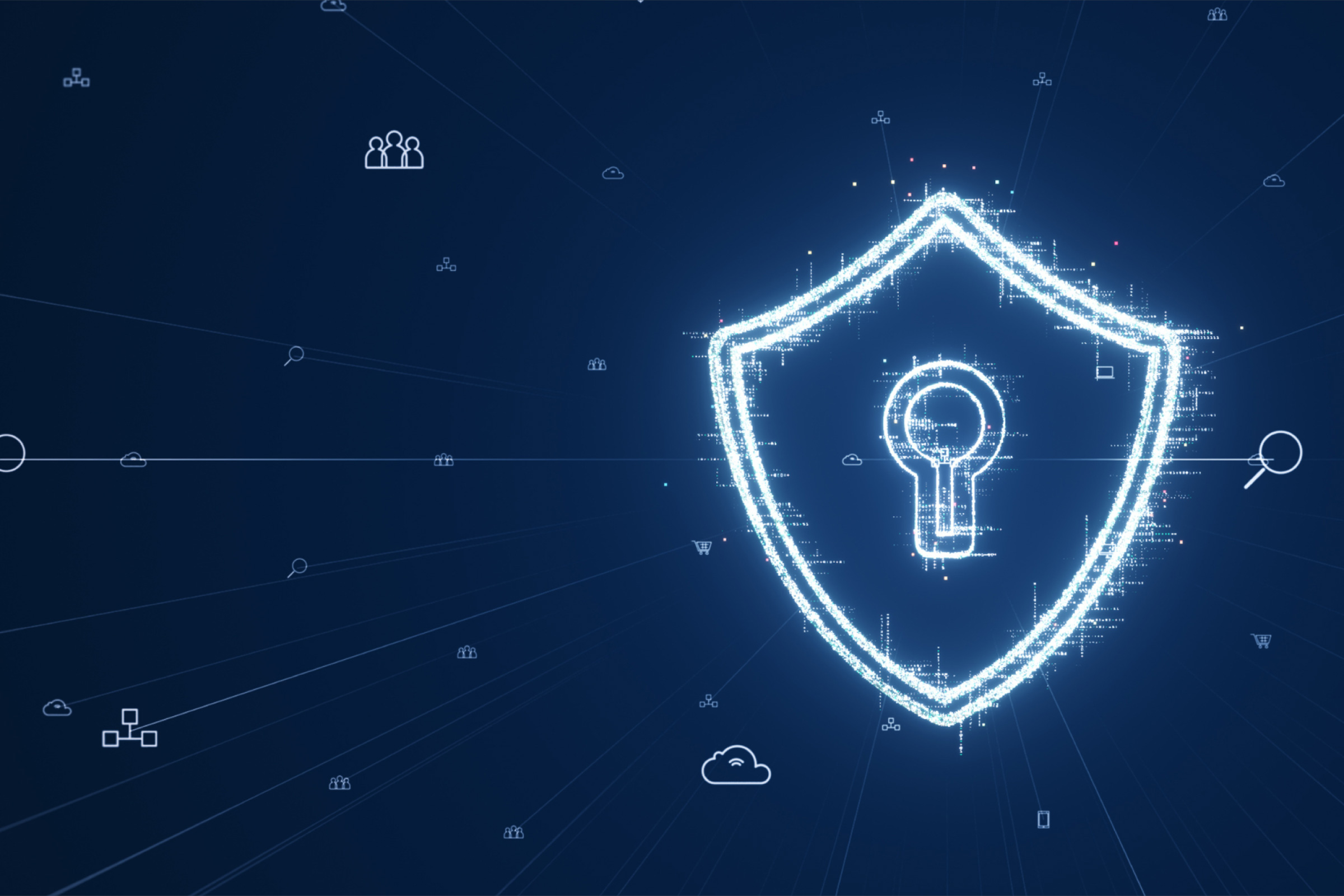What Is Threat Intelligence?
Threat intelligence is the process of gathering, analyzing, and interpreting information about potential or actual cyber threats to an organization. It’s a proactive approach that helps organizations understand the threat landscape, identify risks, and implement effective security controls to protect systems and data.
The process focuses on turning raw data into actionable insights that help organizations prevent, detect, and respond to cyberattacks. To achieve that it goes beyond simply gathering information by aligning those insights with the organization’s specific context. For instance, threat intelligence can reveal if a certain malware family is actively targeting financial firms, or if a spike in phishing attacks is relevant based on observed adversary behavior, building accurate threat profiles allows organizations to anticipate and disrupt attacks before significant damage occurs.
Key components of threat intelligence include:
- Threat data collection: Gathering information from various sources, including open-source intelligence (OSINT), threat feeds, and security logs.
- Data analysis: Investigating the collected data to conclude about potential threats, by identifying patterns, trends, and potential threats.
- Interpretation: Interpreting the analyzed data to understand the context, potential impact, and relevance to the organization.
- Dissemination: Sharing the threat intelligence with relevant teams within the organization, such as security teams, incident responders, and management.
- Action: Taking concrete actions based on the threat intelligence, such as updating security controls, blocking malicious traffic, or developing incident response plans.
Key components of threat intelligence include:
- Strategic threat intelligence: Focuses on long-term trends, attacker motivations, and the overall threat landscape.
- Operational threat intelligence: Focuses on the tactics, techniques, and procedures (TTPs) used by attackers.
- Tactical threat intelligence: Focuses on specific, real-time indicators of compromise (IoCs) that can be used to detect and respond to attacks.
Benefits of Cyber Threat Intelligence
Threat intelligence offers tangible advantages for organizations looking to strengthen their cybersecurity posture. By turning threat data into operational insights, it enables proactive, rather than reactive, defense strategies.
- Improved incident response: Helps security teams quickly understand the scope and impact of threats, reducing response time and minimizing damage.
- Proactive defense: Enables organizations to anticipate threats and take preventive measures before attacks occur.
- Enhanced security operations: Supports better decision-making for SOC teams by providing context around alerts and potential threats.
- Risk-based prioritization: Helps focus security efforts on threats that are most relevant to the organization’s environment and industry.
- Better resource allocation: Reduces wasted effort by directing attention to genuine threats, improving efficiency across security functions.
- Threat actor attribution: Aids in identifying who is behind an attack, their goals, and methods—vital for strategic planning and law enforcement collaboration.
- Support for compliance and reporting: Provides documentation and insights that assist in meeting regulatory requirements and conducting audits.
Learn more in our detailed guide to cyber threat intelligence
The Threat Intelligence Lifecycle
1. Requirements
The requirements phase sets the foundation for the intelligence process by defining what information needs to be collected and why. Security teams, business stakeholders, and executive leadership collaborate to identify their most pressing concerns: sectors most vulnerable to attack, business-critical assets, or suspected adversaries. Precise requirements ensure intelligence efforts are focused on specific risks and objectives that matter to the organization’s mission.
If requirements are not well defined, teams may waste resources chasing irrelevant data or overlook critical threats. Effective requirements gathering considers regulatory obligations, industry trends, and historical incidents, shaping questions such as “What attack vectors do we most need to monitor?” or “Who is targeting organizations like ours?” Establishing clear priorities at this stage ultimately determines the success of the entire threat intelligence lifecycle.
2. Threat Data Collection
Collection involves gathering raw data from a wide range of sources. This can include automated feeds of indicators like malicious IP addresses, proprietary security telemetry, public datasets, dark web forums, social media, and reports from intelligence sharing groups or industry partners. The key is to combine both technical data points and contextual information relating to attacker behaviors, motives, and capabilities.
A well-structured collection strategy considers the value, reliability, and timeliness of each source. Security teams should ensure legal and ethical standards are followed, particularly when accessing restricted or sensitive forums. The diversity and quality of the collected information form the raw material that feeds into the next steps of processing and threat data analysis.
3. Data Processing
In the processing phase, collected threat intel is transformed into a structured, usable format. This often involves normalization—removing duplicates, confirming validity, and translating information into standardized schemas or formats readable by security tools. Automated scripts or security orchestration platforms can help sift through large quantities of data, tagging fields like IP addresses, file hashes, or URL indicators.
Effective processing handles the scale and complexity typical in cybersecurity environments, ensuring critical information isn’t lost in a flood of irrelevant data. Filtering out noise and irrelevant records allows analysts to prioritize high-confidence indicators. This structured, processed data can then move through to analysis for further interpretation.
4. Analysis and Interpretation
Analysis is where raw, processed data becomes actionable intelligence. Analysts interpret indicators, correlate events, and look for patterns that suggest specific threats, attack campaigns, or emerging adversary techniques. High-quality analysis provides context for the data by answering questions such as who is behind an attack, what their likely objectives are, and what impact an incident could have on the organization. The analysis process benefits from both automated correlations and expert human judgment.
While algorithms can identify trends and matches at scale, skilled analysts provide the critical insight needed to assess motive, intent, and potential next steps of adversaries. The result is intelligence that not only details existing threats but also provides guidance on mitigation, future prevention, and strategic adjustments.
5. Dissemination
Dissemination is the distribution of threat intelligence findings to relevant stakeholders across the organization. This includes not just security teams, but also executive leadership, IT operations, and business units that could be affected by cyber incidents. The format and detail level of intelligence reports should be appropriate for each audience, ensuring technical details reach those who need them while strategic assessments reach senior decision-makers.
Timely dissemination is critical. If intelligence arrives late or is buried in irrelevant detail, it cannot support urgent decisions or immediate defensive actions. Many organizations leverage automation, dashboards, and alerting systems for real-time dissemination, allowing relevant parties to respond quickly to imminent threats or newly discovered vulnerabilities.
6. Feedback
The feedback stage closes the intelligence loop by gathering responses from stakeholders regarding the utility, clarity, and effectiveness of delivered intelligence. Feedback may highlight areas where intelligence products succeeded, failed, or missed critical information, enabling teams to adjust future requirements and improve subsequent cycles in the lifecycle.
Regular feedback helps ensure threat intelligence stays relevant to changing business needs and threat environments. As organizations evolve, and attackers adapt, the requirements for intelligence will shift. Incorporating structured feedback into the lifecycle underscores that threat intelligence is an ongoing, adaptive process.
Tips from the Expert

Dima Potekhin, CTO and Co-Founder of CyCognito, is an expert in mass-scale data analysis and security. He is an autodidact who has been coding since the age of nine and holds four patents that include processes for large content delivery networks (CDNs) and internet-scale infrastructure.
In my experience, here are tips that can help you better operationalize threat intelligence in 2025 and beyond:
- Instrument your own attack surface for self-generating intelligence: Leverage honeypots, deception technologies, and shadow asset monitoring to generate first-party threat intelligence from your own environment. This creates highly relevant, real-time insights tailored to the infrastructure and attacker interest.
- Correlate threat intelligence with business impact models: Use business impact assessments (BIAs) and crown jewel mapping to assign intelligence severity based on affected business processes. This approach improves prioritization and links threats to enterprise risk in terms executives understand.
- Integrate threat intelligence into change management workflows: Intelligence often uncovers risks tied to recent changes (e.g., a new internet-facing API). Embed intelligence review checkpoints into DevOps pipelines, CI/CD flows, and IT change tickets to proactively catch threat exposures early.
- Use threat intelligence to validate third-party risk continuously: Extend the threat intelligence program to monitor vendors, partners, and suppliers. Track mentions of their infrastructure in threat feeds or dark web forums to detect potential upstream compromise or targeting.
- Establish adversary-in-the-loop simulations: Move beyond red team exercises by incorporating real-world threat actor TTPs into live simulations. Use threat intelligence to mimic known adversaries in tabletop or purple team drills, making them more realistic and threat-representative.
Types of Threat Intelligence
Strategic Intelligence
Strategic threat intelligence delivers a high-level overview of the threat landscape, focusing on long-term trends, adversary motivations, geopolitical developments, and risks facing the entire organization. Often used by senior leadership and board members, this intelligence shapes broad security strategies and investment decisions. It addresses questions like which nation-states or criminal groups are most active in a given sector, and how global events could influence cyber risk.
Unlike operational or tactical intelligence, strategic threat intelligence is less concerned with technical indicators or daily incidents. Instead, it equips decision-makers with the context needed for setting security budgets, influencing corporate policy, and meeting regulatory obligations.
Tactical Intelligence
Tactical threat intelligence provides the “how” of cyber attacks: the tools, tactics, and procedures (TTPs) adversaries are currently using. This intelligence directly informs security operations by supplying details on specific malware variants, attack vectors, credential theft techniques, and evasion methodologies. Security defenders rely on tactical intelligence to refine detection logic and harden vulnerable systems.
Tactical intelligence is best suited for use by security analysts and incident responders. It bridges the gap between raw data and hands-on defense by connecting observable artifacts—such as malicious file hashes or phishing email patterns—to active threats. When updated regularly, tactical intelligence helps teams adapt to the latest attack methods and block threats before they escalate.
Operational Intelligence
Operational threat intelligence focuses on active campaigns, ongoing incidents, and the immediate tactics and plans of threat actors. This intelligence enables security teams to understand the context of attacks in near real-time—such as who is targeting the organization currently, their methods, and the infrastructure they use. It provides timely information that supports incident response, threat hunting, and network defense.
Analysts use operational intelligence to prioritize and direct defensive actions based on current events, ensuring responses are relevant and proportionate. It integrates technical threat intel with up-to-date insights into adversary behavior, helping to coordinate efforts during active attacks.
What Are Threat Intelligence Feeds?
Threat intelligence feeds are continuous streams of data related to new and evolving cyber threats. Typically delivered via APIs or integrated platforms, these feeds supply up-to-date indicators such as malicious IPs, domains, URLs, file hashes, and details about attack campaigns. Organizations can automatically ingest these feeds into their security tools, enabling faster detection and blocking of known threats.
The value of threat intelligence feeds depends on their timeliness, accuracy, and relevance to the organization’s environment. Not all feeds are created equal—some offer broad, general-purpose indicators, while others focus on specific regions, industries, or attack vectors. Effective integration of multiple feeds, combined with internal threat analysis, enables organizations to proactively defend against both commodity and targeted attacks.
Use Cases for Threat Intelligence
Proactive Incident Response
Threat intelligence enables proactive incident response by providing early warnings about active campaigns and ongoing attacks. Real-time intelligence can signal when a new threat is targeting your sector or infrastructure, allowing security teams to take preventive action before adversaries achieve their objectives. When integrated into incident response workflows, intelligence reduces response times and supports more effective containment and recovery efforts.
By leveraging detailed context about attackers’ methods and objectives, responders can tailor their actions to the specifics of each incident. This approach leads to more effective responses and improved understanding for future threat mitigation.
Vulnerability Prioritization
Organizations face a constant barrage of new vulnerabilities, but not all pose equal risk. Threat intelligence supports vulnerability prioritization by correlating real-world exploitation trends, active attacks, and adversary interests with an organization’s unique asset profile. Security teams can identify which vulnerabilities are actively being targeted or fit known attacker behaviors, focusing patching efforts on the highest-risk areas.
This targeted approach prevents wasted resources on low-impact issues and reduces the attack surface faster. By integrating threat intelligence with vulnerability management platforms, organizations maintain better control over patching cycles and significantly reduce their exposure to the most dangerous attack vectors.
Threat Hunting and Detection
Threat intelligence is a critical enabler for threat hunting activities. By supplying up-to-date indicators, attack patterns, and adversary tactics, intelligence allows hunters to proactively search for threats that have bypassed traditional controls. These insights drive hypothesis-driven investigations and help surface stealthy attackers who might otherwise remain undetected within the environment.
Detection capabilities also benefit from integrating threat intelligence with security tools—such as SIEM and EDR platforms—which can use intelligence to enrich alerts and expose previously hidden threats. By keeping threat hunters aligned with the latest adversary trends, organizations can maintain a defensive edge against both established and emerging tactics.
Security Awareness and Training
Incorporating threat intelligence into security awareness programs increases their relevance and impact. Real-world examples of attacks—such as current phishing campaigns or the latest social engineering tactics—make training relatable and memorable for users. This helps staff recognize and report suspicious behavior, reducing the likelihood of successful attacks.
Regularly updating training content with intelligence-driven insights ensures employees remain vigilant in the face of evolving threats. Security teams can proactively warn users about new scams and trends, building a more resilient workforce that serves as an active line of defense against cyber incidents.
Challenges of Threat Intelligence
Here are some challenges organizations face when implementing threat intelligence into their security operations.
Data Quality and Volume Overload
The sheer volume of threat data can easily overwhelm security teams. Daily, organizations ingest massive quantities of indicators, logs, and alerts from multiple sources—many of which are irrelevant, redundant, or inaccurate. Poor threat intel quality leads to wasted analyst time, increased false positives, and the risk of missing real threats hidden within the noise.
Filtering, validating, and contextualizing intelligence is resource-intensive and requires careful investment in tooling and automation. Effective threat intelligence programs must prioritize data quality over quantity, ensuring that only actionable and relevant information reaches decision-makers and front-line defenders.
Skill and Resource Gaps
Successful threat intelligence programs require expert analysts with a mix of technical, analytical, and investigative skills. However, a shortage of skilled personnel and resources is a persistent challenge. Many organizations struggle to recruit and retain qualified threat intelligence professionals, leading to operational gaps and underutilization of intelligence capabilities.
Resource constraints can also hamper technology investments, affecting threat data collection, processing automation, and analysis platforms. Once threat intelligence gaps are identified, addressing them equires ongoing training, collaboration with intelligence sharing communities, and, in some cases, leveraging managed services or third-party expertise.
Attribution Difficulties and Deception
Attributing cyber attacks to specific threat actors or groups is a complex undertaking. Attackers routinely use misdirection techniques—such as false flags, spoofed infrastructure, and reused malware—to evade attribution or implicate rivals. This makes it difficult for defenders to determine the true source, intent, or political backing behind any given incident.
Deception by adversaries can also undermine the trustworthiness of collected intelligence or lead investigators down false paths. Overcoming attribution challenges depends on improved information sharing, rigorous analysis, and cross-referencing between multiple intelligence sources. Even then, absolute certainty is often out of reach, and conclusions about attribution should be communicated carefully to stakeholders.
What Is a Threat Intelligence Platform?
A threat intelligence platform (TIP) is a software solution designed to aggregate, normalize, enrich, and manage threat data from multiple sources. It acts as a central hub where raw threat intelligence—such as indicators of compromise (IOCs), tactics, techniques, and procedures (TTPs), and contextual threat information—is collected, processed, and made actionable.
TIPs help automate and streamline the threat intelligence lifecycle by integrating with security tools like SIEMs, EDR systems, and firewalls. This allows organizations to correlate internal telemetry with external intelligence, prioritize alerts based on relevance, and automate defensive actions. Many platforms offer features such as threat scoring, indicator de-duplication, visualization dashboards, and collaboration tools for threat analysts.
By reducing manual workloads and improving the quality and speed of analysis, TIPs enhance situational awareness and support faster, more informed decision-making in security operations.
Considerations for Choosing Threat Intelligence Tools
Choosing the right threat intelligence tools involves aligning capabilities with organizational needs, technical requirements, and available resources. The following factors are essential when evaluating and selecting tools:
- Data relevance and contextualization: Select tools that provide intelligence tailored to your industry, region, and threat landscape. Contextual information—such as targeted sectors, attack timelines, and adversary motivations—enhances decision-making and reduces noise.
- Integration with existing systems: Tools should integrate smoothly with your current security infrastructure, including SIEM, SOAR, EDR, and firewalls. Seamless integration ensures threat intelligence enhances threat detection, response, and automation workflows.
- Scalability and performance: Ensure the platform can scale to match your organization’s size and data volume. High ingestion rates, fast query capabilities, and reliable uptime are critical for operational environments.
- Data quality and source transparency: Choose vendors that provide high-confidence indicators and clear sourcing practices. Tools should offer mechanisms to validate, score, and filter intelligence to avoid false positives and irrelevant alerts.
- User interface and accessibility: An intuitive UI and support for custom dashboards improve usability. Analysts should be able to explore intelligence without excessive training or dependence on technical staff.
- Customization and automation: Look for tools that allow rule customization, alert tuning, and automated responses. Automation accelerates threat detection and reduces analyst fatigue.
- Vendor support and community involvement: Strong vendor support, threat research teams, and participation in intelligence-sharing communities (like ISACs) enhance the credibility and usefulness of the tool.
- Cost and licensing models: Evaluate pricing based on coverage, data types, and deployment models. Consider the total cost of ownership, including training, integration, and ongoing support.
Best Practices for Effective Threat Intelligence
1. Combine Intelligence Types for Full Coverage
Combining strategic, tactical, and operational threat intelligence provides comprehensive visibility into the threat landscape. Strategic intelligence helps security leaders align cyber defense efforts with business goals and long-term risks. It identifies which threat actors are targeting specific industries, the geopolitical factors influencing attack trends, and the broader economic or regulatory impacts of cyber threats.
Tactical intelligence offers security operations center (SOC) teams the indicators they need for real-time threat detection, such as file hashes, IP addresses, and DNS patterns. These details feed directly into SIEM, IDS, and endpoint detection systems for automated blocking or alerting.
Operational intelligence ties the two together by contextualizing specific campaigns or identify threat actors, and threat actor activity. It answers questions like “Which attacker is exploiting this CVE right now?” or “Which tools are being used against organizations in our sector this week?” By integrating all three intelligence types, teams can link strategic risks with concrete technical defenses and dynamic threat response.
2. Intelligence Sharing and Collective Defense
Threat intelligence becomes significantly more powerful when shared across trusted communities. Intelligence sharing helps identify coordinated campaigns, zero-day exploits, and attacker infrastructure before they become widespread. Many attackers reuse tactics across multiple victims, so early warnings from peers can provide a critical advantage.
Organizations should participate in sector-specific Information Sharing and Analysis Centers (ISACs), regional CERTs, and threat-sharing alliances like the Cyber Threat Alliance (CTA). Sharing formats such as STIX/TAXII and open exchange platforms like MISP allow standardized, machine-readable sharing while preserving confidentiality and integrity.
Sharing doesn’t mean revealing sensitive internal data. Effective contributions can include anonymized IOCs, TTPs, and incident summaries. Legal frameworks such as the Cybersecurity Information Sharing Act (CISA) in the U.S. offer some liability protections.
3. Utilize Predictive Threat Intelligence and Autonomous Hunting
Predictive threat intelligence leverages AI, threat modeling, and historical attack patterns to identify emerging threats before they are widely observed. For example, machine learning can detect subtle changes in attacker infrastructure or anomalous behavior in telemetry that may indicate staging for a future campaign.
Autonomous threat hunting uses these predictive signals to launch automated, hypothesis-driven investigations. These systems continuously query internal logs, endpoint data, and network telemetry, searching for hidden adversaries or early signs of compromise. Techniques include anomaly detection, behavior baselining, and chaining of indicators across attack stages.
By integrating predictive analytics with autonomous hunting tools (e.g., through SOAR platforms or extended detection and response (XDR) systems), organizations can reduce the mean time to detect and respond (MTTD/MTTR).
4. Integrate OSINT with Cyber-Human Intelligence
OSINT sources—such as public blogs, social media, domain registration databases, and paste sites—offer a broad view of threat actor chatter, vulnerabilities, and leaked credentials. Tools like Shodan, VirusTotal, and GitHub monitoring can uncover attacker reconnaissance or misconfigurations.
However, OSINT is often noisy, incomplete, and prone to manipulation. Cyber-human intelligence (HUMINT), gathered from vetted contacts in underground forums, private threat-sharing groups, and confidential vendor reports, fills in the gaps with verified insights and deeper context. HUMINT can reveal adversary intent, planned attack windows, and custom malware tools not seen in public datasets.
Combining OSINT with HUMINT ensures a richer, more accurate intelligence picture. Automation can collect and triage OSINT, while skilled analysts validate findings and extract insights from human sources. This hybrid approach improves attribution, threat modeling, and detection engineering.
5. Regularly Update and Review Intelligence
Static intelligence quickly becomes outdated in modern threat environments. Adversaries evolve TTPs, change infrastructure, and adapt to defensive measures within days or even hours. Threat intelligence must be continuously refreshed through automated feed ingestion, analyst updates, and integration with live telemetry from internal sensors.
Organizations should schedule regular reviews of their intelligence processes—monthly or quarterly at minimum. This includes reassessing collection sources, evaluating feed performance (e.g., detection rate vs. false positives), and reviewing previous intelligence products for accuracy and impact.
Feedback from SOC teams, red/blue team exercises, and incident post-mortems should inform ongoing improvements. Continuous validation, such as replaying known attacks in a sandbox or threat simulation environment, helps refine detection rules and intelligence applicability. Effective programs treat threat intelligence as a living capability, not a static dataset.
Threat Intelligence with CyCognito
CyCognito is an external exposure management platform that enables granular Attack Surface Management (ASM) by uncovering and validating every external asset attackers could target (including unknown, unmanaged, and cloud-based systems).
Using reconnaissance techniques similar to those of sophisticated threat actors, the platform maps your organization’s entire external attack surface, then continuously tests and prioritizes exposures so security teams can focus on most relevant threats, reducing mean time to the mean time to detect (MTTD), contain (MTTC) and respond (MTTR).
The intelligence generated by CyCognito—asset discovery, business and technology context, attractiveness to adversaries, and validation through active testing—can be fed directly into existing threat intelligence processes. This data enriches analysis, improves prioritization, and ensures that remediation efforts focus on exposures most likely to be exploited based on real-world trends (including KEV data and attacker behavior patterns).
By delivering a complete, validated, and prioritized view of the external attack surface, CyCognito not only strengthens attack surface management but also makes threat intelligence outputs more relevant, actionable, and closely aligned with actual attacker activity.












